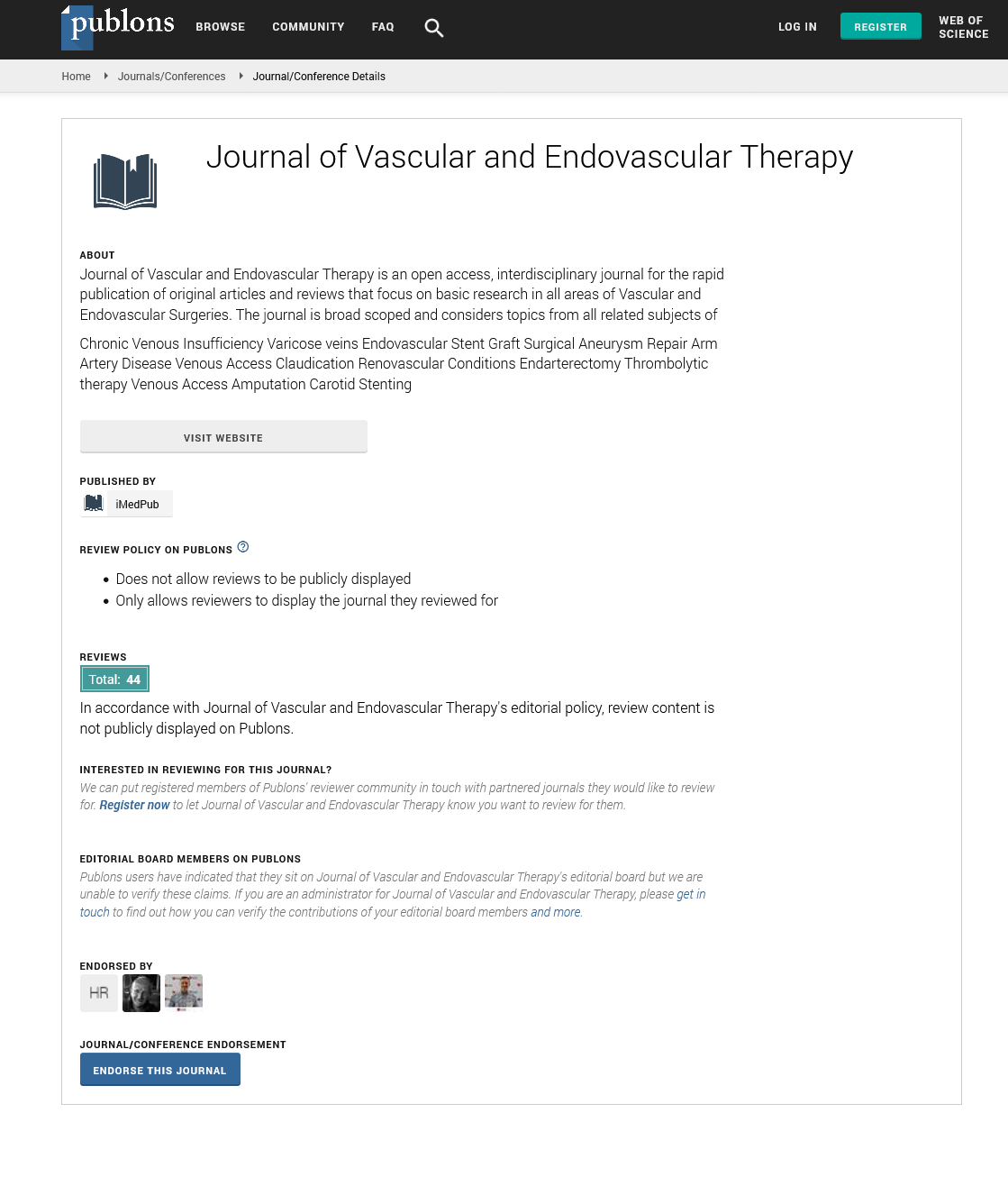ISSN : 2634-7156
Journal of Vascular and Endovascular Therapy
Covered stents: when and how to use?
4th Edition of World Congress & Exhibition on Vascular Surgery
March 28-29, 2019 Rome, Italy
Paulo Eduardo Ocke Reis, Leonardo Roever, Marcello Rotolo Nascimento,Gustavo Petorossi Solano, Daniel Paixao and Jean Moura Netto
Federal Fluminense University, Brazil Vascular Clinic Ocke Reis, Rio de Janeiro, Brazil Federal University of Uberlandia, Minas Gerais, Brazil
ScientificTracks Abstracts: J Vasc Endovasc Therapy
DOI: 10.21767/2573-4482-C1-005
Abstract
The first commercially available covered stent was Corvita®, which was developed in Belgium by Jean Pierre Becquemin. Covered stents have expanded the use of endovascular procedures, they can be either with Dacron (Wallgraft®) or polytetrafluoroethylene (PTFE), examples: Solaris®, Viabahn®, iCast®, outside the United States called Advanta® V12, Jostent® and Fluency®. They can be balloon-expandable (iCast® or Advanta® V12) or selfexpandable (Solaris®, Viabahn®, Jostent®, Wallgraft®). The treatment of vascular disease has changed dramatically during the last two decades. They are used mainly for the treatment of traumatic arterial lesions, arteriovenous fistulas or false aneurysms, peripheral aneurysms and, more recently, for the treatment of obstructive vascular disease of the aortoiliac and femoropopliteal sectors. To treat visceral artery aneurysms (vaas) covered stents can be useful, when the artery is not so tortuous and the vaas are not intraparenquimal. The major technical limitations to implant it in vaas are severe tortuosity, calcification or sometimes small caliber arteries. There are a lot of available stent grafts, we are getting experience, now, with the new brazilian covered stent, Solaris®. This stent-graft is more radiopaque than other conventional nitinol stents available in Brazil, it is a flexible self-expanding stent graft with PTFE. Those stents are a barrier to the ingrowth of neointimal hyperplasia, sealing off the inflammatory surface, and thus have the potential to inhibit restenosis. For the treatment of vascular trauma, hemorrhage, aneurysmal disease, or even for stent grafts used for aortic aneurysms, several minimally invasive therapies are available. This video gives an overview of our experience in the currently available covered stents and they’re useful.
Recent Publications
1. Desgranges P, Mialhe C, Cavillon A et al. (1997) Endovascular repair of posttraumatic thoracic pseudoaneurysm with a stent graft. Am J Roentg 169:1743-5.
2. Raherinantenaina F, Rajaonanahary T M A and Rakoto Ratsimba H N (2015) Update on diagnostic and therapeutic features of peripheral artery pseudoaneurysms following orthopedic and traumatologic surgery. Rev Vasc Med 3:16e21.
3. P E Ocke Reis, L Roever, I F Ocke Reis, et al. (2016) Endovascular stent grafting of a deep femoral artery pseudoaneurysm. EJVES Short Rep. 33:5-8.
4. P E Ocke Reis, Roever L and Reis I F O (2016) Embolization for visceral artery aneurisms: what’s your opinion? Journal of Vascular and Endovascular Surgery doi: 10.21767/2573- 4482.100001.
5. Gilbertson J J, Pettengill O S and Cronenwett J L (1992) Antiproliferative effect of heparin on human smooth muscle cells cultured from intimal hyperplastic lesions of vein grafts. Ann Vasc Surg. 6:265-271.
Biography
Paulo Eduardo Ocke Reis is a Specialist in Vascular and Endovascular Surgery. Professor of Vascular Surgery and Coordinator of the Vascular Surgery Service, HUAP, Federal Fluminense University at Niterói / Rio de Janeiro / Brazil. European Journal Vascular Endovascular Short Reports, Editorial Board, Associate Editor. Editor-in-Chief of the Journal of Vascular & Endovascular Therapy open access. Specialization at Vascular Surgery and Angiorradiology, Endovascular Surgery, Fellow-Vascular Research at Albert Einstein College of Medicine. Ph.D. at Ciências Morfológicas by UFRJ / BRAZIL (2009).
E-mail: ockereis@yahoo.com
Google Scholar citation report
Citations : 177
Journal of Vascular and Endovascular Therapy received 177 citations as per Google Scholar report
Journal of Vascular and Endovascular Therapy peer review process verified at publons
Abstracted/Indexed in
- Google Scholar
- Open J Gate
- Publons
- Geneva Foundation for Medical Education and Research
- Secret Search Engine Labs
Open Access Journals
- Aquaculture & Veterinary Science
- Chemistry & Chemical Sciences
- Clinical Sciences
- Engineering
- General Science
- Genetics & Molecular Biology
- Health Care & Nursing
- Immunology & Microbiology
- Materials Science
- Mathematics & Physics
- Medical Sciences
- Neurology & Psychiatry
- Oncology & Cancer Science
- Pharmaceutical Sciences
